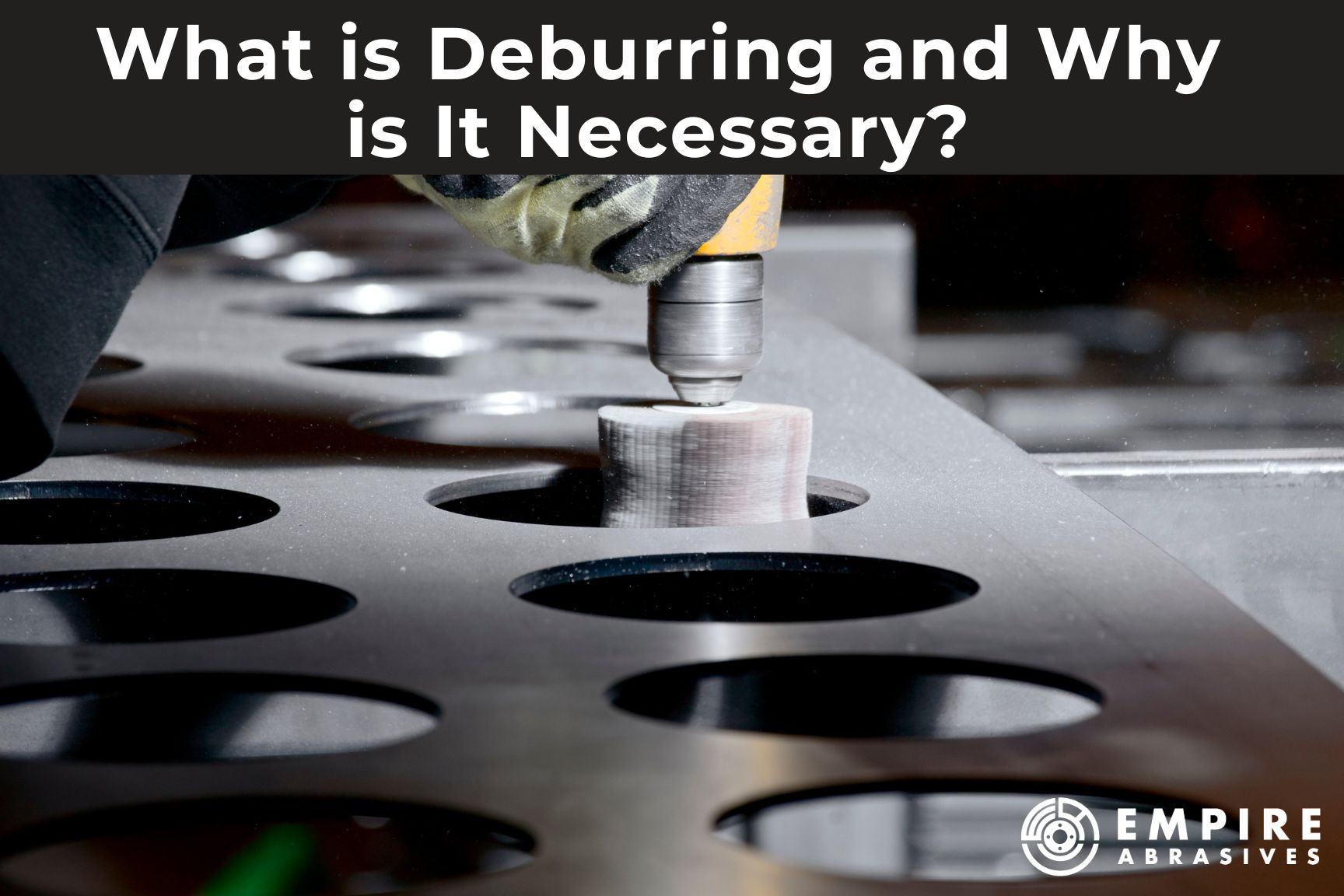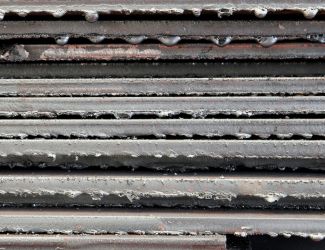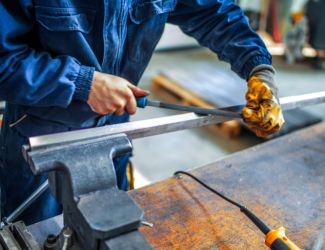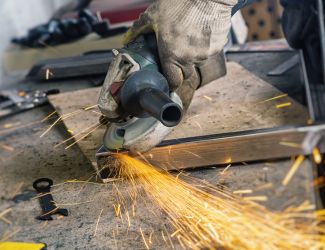
When you buy unfinished metal, it will likely have some rough edges. These are created during the manufacturing process, usually when the metal is cut or milled. The metal shop’s job is to cut and/or process the metal, then it becomes your job to clean it up. In this post we’ll talk about those rough edges, aka burrs, and why removing them (deburring) is important..
What is Deburring?
Deburring is a metalworking process that removes rough or sharp edges (burrs) from metal. There are several different methods and many different tools used to deburr metal. The most common deburring methods are:
Manual Deburring
This is a very common method for deburring small pieces of metal or for quick DIY projects. It’s also the most labor-intensive and time consuming way.
Manual deburring removes metal burrs by hand using tools like sandpaper, deburring knives, abrasive stones, or hand held metal files. This is a great technique for when you have a small surface area that needs to be deburred, or when you need to remove burrs form hard to reach areas.
Mechanical Deburring
This is a much faster way to remove burrs than the manual option, and can often be done with tools that many people already have in their toolbox. Mechanical deburring is a burr removal method that uses machines, either handheld or specialized deburring tools. Some techniques of mechanical deburring include:
- Grinding:
- Method: High-speed rotation of an abrasive product against the workpiece to remove burrs
- Tools: Bench grinders, surface conditioning tools, angle grinders, die grinders
- Attachments: Grinding belts, grinding stones, grinding wheels, flap discs, sanding drums
- Brushing:
- Method: Rotating brushes or bristled aggressively spin or sweep across the surface to remove burrs
- Tools: Deburring brushes, brush deburring machines, angle grinders, handheld rotary tools
- Attachments: Wire wheels and brushes, wire drums
- Milling:
- Method: Cutting away burrs with specialized tools and creating a desired edge profile
- Tools: CNC milling machines, end mills
- Attachments: Deburring end mills, chamfering mills, tungsten carbide burrs
- Vibratory Finishing:
- Method: Placing parts in a vibrating container with abrasive media to remove burrs and smooth surfaces through friction
- Tools: Vibratory tumblers, centrifugal disc finishers
- Attachments: Abrasive media (ceramic, plastic, steel), polishing media
- Abrasive Flow Machining:
- Method: Abrasive media is forced through internal passages to deburr complex parts
- Tools: Abrasive flow machines
- Attachments: Abrasive media (usually a putty-like material with abrasive particles)
Thermal Deburring (TEM)
Also known as Thermal Energy Method (TEM), this is not something you’ll find in someone's personal garage. It requires specialized equipment and trained operators to perform. Thermal deburring is a technique that uses very high temperatures and corrosive gasses to vaporize burrs with very short explosions. The process removes burrs and other raised imperfections without damaging the underlying metal. It’s commonly used in automotive, aerospace, and medical industries.
Electrochemical Deburring (ECD)
Electrochemical deburring, also known as electrolytic deburring, is a highly specialized and precise process. ECD is used to remove burrs, sharp edges, or imperfections from a workpiece's surface through electrolysis using an electrical current and an electrolyte solution. Since it requires an electric current, this process is limited to electrically conductive materials.
Electrochemical Deburring Process:
- The metal part (anode) and a tool electrode (cathode) are immersed in an electrolyte solution, often Sodium Chloride (NaCl) or Sodium Nitrate (NaNO3) along with additives.
- The anode (+) and the cathode (-) are placed close to one another, without touching.
- A low voltage direct current is applied, creating an electrochemical reaction.
- Metal ions from the burrs are dissolved into the electrolyte, effectively removing the burrs.
- The electrolyte flows through the gaps between the metal part and electrode tool. The dissolved metal ions and debris flow away from the metal, preventing them from re-depositing on the part.
What Causes Burrs?

Burrs are a byproduct of modifying metal in one way or another. Small pieces of material remain attached to the parts of the surface that were altered. Burrs are primarily caused by:
- Cutting: Cutting metal by sawing, shearing, punching, drilling, milling, and turning create burrs along the cut edges or holes. The cutting action causes the metal to deform and tear, leaving behind raised edges.
- Stamping and Forming: When metal is stamped, bent, or formed, the deformation often causes it to stretch and break, resulting in burrs along the edges or creases.
- Casting and Molding: Casting or molding processes can leave behind burrs as the molten metal seeps into small gaps in the mold or where metal solidifies in unintended areas.
- Machining: Turning, milling, drilling, grinding, and other machining processes can generate burrs by leaving raised surface material through abrasive action or from the heat deforming the metal.
- Metal Fabrication: Welding, brazing, and other fabrication processes can create burrs where the materials are joined or fused together. The intense heat and subsequent cooling can cause the metal to form irregular edges and protrusions at the joints.
- Forging: Forging shapes metal through localized compressive forces, usually at high temperatures. This deformation of the metal from forging can cause excess material to squeeze out at the edges, forming burrs.
Types of Metal Burrs
Each of the different causes of burrs mentioned above creates different types of burs. Knowing which type of burr you’re dealing with will help you determine the deburring method you should use.
Rollover Burrs (Bending Burrs):
These are a very common type of burr. They can usually be found at the exit point of a cutting tool. They get their name from the way they are formed during machining processes like cutting or milling. The material being cut doesn’t get cleanly sheared off and is pushed or "rolled over" the cutting edge, creating a raised edge or burr.
Poisson Burrs (Lateral Flow Burrs):
These burrs form under compressive forces. When pressure is applied to part of the workpiece, it will typically push material out in a perpendicular direction. They are named after the Poisson Effect, which explains that when a material is compressed in one direction, it tends to expand in the other two perpendicular directions. And on the other hand, if the material is stretched, it contracts transversely to the stretching direction.
Tear Burrs:
Tear burrs can be caused when a cutting tool isn't sharp enough or the cutting speed is too high, causing the metal to tear instead of being cleanly cut. This leaves behind very sharp burrs at the tear location.
Cut-off Burrs (Breakout Burrs):
These are small, raised fragments of material left behind after a cut is completed. They can be either protruded or indented and are often found at the separation point where the material was cut off.
Thermal Burrs:
Thermal burrs are also referred to as weld slag, spatter, or dross. These form during high heat processes like welding, plasma cutting, and laser cutting. They often appear as melted or re-solidified beads of material, which can be very challenging to remove.
Recommended Deburring Methods for Each Burr Type
| Burr Type | Preferred Deburring Processes | Notes |
| Rollover Burrs | Grinding, Brushing, Milling | These processes can effectively remove the raised edge of a rollover burr while maintaining the desired shape of the workpiece. |
| Poisson Burrs | Brushing, Vibratory Finishing | Brushing and vibratory finishing are gentler processes that can remove thin, raised Poisson burrs without altering the dimensions of the workpiece. |
| Tear Burrs | Grinding, Milling | These processes can remove the jagged edges of tear burrs and smooth the surface. |
| Cut-off Burrs | Brushing, Vibratory Finishing, Manual Deburring | These methods are suitable for removing small, raised cut-off burrs. Manual deburring with a file or scraper can be particularly effective for individual burrs or hard-to-reach areas. |
| Thermal Burrs | Grinding, Milling, Thermal Deburring (for larger burrs) |
Grinding and milling can effectively remove thermal burrs, while thermal deburring can be used to remove larger burrs from multiple surfaces simultaneously. |
Why is Deburring Necessary
Now that you know all about what burrs are, what types of burrs there are, and the different deburring methods, it’s probably a good idea to tell you why deburring metal is important.
- Safety:
- Burrs can be sharp and cause cuts or injuries to workers and consumers.
- Stress on the burr can lead to it breaking off, creating a projectile hazard.
- Functionality:
- Burrs can interfere with the proper fit and function of parts, leading to jamming, malfunctions, or premature wear.
- They can disrupt smooth surfaces, affecting airflow, the flow of fluids, or cause electrical short circuits or poor connections.
- Aesthetics:
- Metal parts without burrs look cleaner and more professional.
- Burrs can interfere with the coatings and finishes.
- Product Durability and Lifespan:
- Burrs create stress points that can lead to cracks or fractures.
- They can trap moisture and contaminants that may lead to corrosion.
- Assembly:
- Burr-free parts are easier to handle and assemble, reducing the time and effort to manufacture a finished product.
- Deburring reduces the need for rework and adjustments.
- Legal Regulatory Compliance:
- Some industries, such as aerospace, medical devices, or food processing have specific regulations and standards that mandate the removal of burrs.
Expert Advice & Premium Deburring Tools
At Empire Abrasives, we offer a wide range of products for both manual and mechanical deburring to meet all your needs. Whether you're working on small DIY projects or large-scale industrial applications, we have the right deburring tools and supplies to help you achieve a smooth, burr-free finish.
Our team of abrasives experts is available to answer questions during regular office hours by phone, email, or online chat and any messages sent during non-office hours will be responded to promptly the next business day.
For more information or to place an order, browse our online catalog or contact us directly. We're here to help you achieve the best results with the highest quality abrasives on the market. With our fully stocked warehouse, we pride ourselves on fast order processing and shipping. Once your order is placed, it will be shipped out within one business day.


